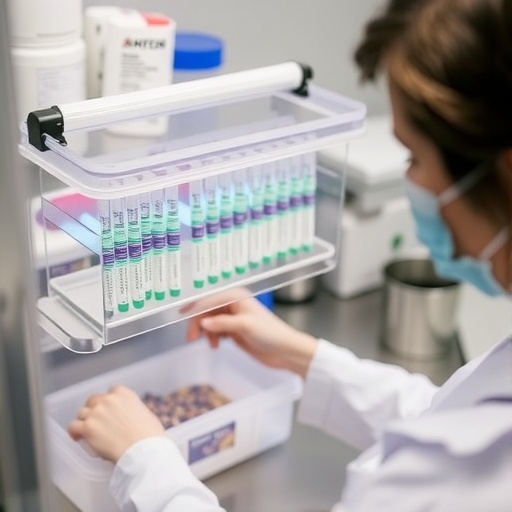
In a groundbreaking advancement in plant genetics, researchers have unveiled a novel approach that significantly enhances the frequency of meiotic crossovers by strategically juxtaposing heterozygous and homozygous chromosomal regions in both Arabidopsis and maize. This discovery, published in the prestigious journal Nature Plants in 2025, opens new avenues for crop improvement and the understanding of genetic recombination mechanisms that are fundamental to plant breeding and biodiversity.
Meiotic crossovers are crucial events that occur during meiosis, the specialized form of cell division that leads to the formation of gametes. These crossovers lead to the exchange of genetic material between homologous chromosomes, promoting genetic diversity. Despite their importance, crossover frequency and distribution are tightly regulated and generally limited, posing natural constraints on plant breeding efforts aiming to shuffle beneficial alleles. The enhancement of crossover frequency, therefore, holds transformative potential for accelerating genetic gains in staple crops.
The study spearheaded by Mikhailov and colleagues delves deep into the genetic and molecular underpinnings governing crossover landscape. Traditionally, crossovers are known to be suppressed in homozygous regions and preferentially occur in heterozygous intervals, but the mechanistic basis and its exploitation had remained elusive. The research team hypothesized that the deliberate juxtaposition of heterozygous and homozygous chromosomal segments could modulate the crossover pattern, effectively increasing recombination rates in targeted genomic intervals.
Leveraging the genetic tractability of the model organism Arabidopsis thaliana alongside the agronomically vital cereal crop maize, the team implemented an innovative experimental design. Through precise genomic engineering and crossing strategies, plant lines were generated that bear distinct patterns of heterozygosity and homozygosity arranged adjacently along chromosomes. This allowed the researchers to monitor crossover frequencies across these engineered chromosomal mosaics using high-resolution genetic mapping and cytogenetic analyses.
Results from their investigations revealed a striking augmentation in local crossover rates at the boundaries where heterozygous and homozygous regions meet. This “juxtaposition effect” appears to create a chromosomal environment conducive to meiotic recombination, overcoming natural suppression typically observed in homozygous tracts. The effect was consistently observed in both Arabidopsis and maize, suggesting a conserved biological mechanism that could be harnessed across diverse plant species.
Further mechanistic insights indicated that this recombination enhancement is linked to the chromatin landscape and the recruitment of key meiotic recombination proteins. It appears that heterozygosity prompts localized chromatin remodeling and signaling that facilitate the recruitment or activation of recombination machinery at adjacent homozygous regions. This spatial coupling between different genetic states effectively breaks down barriers that otherwise limit crossover incidence.
Beyond deepening fundamental understanding of meiosis, this discovery holds significant practical implications for crop genetics. Increased crossover rates enable breeders to more rapidly combine advantageous alleles located in clusters or regions previously recalcitrant to recombination. Traditional breeding programs often struggle to disentangle tightly linked genes because natural crossover events are sparse and unevenly distributed. The ability to engineer crossover landscapes by exploiting heterozygosity geometry thus offers a powerful tool for precision breeding.
Moreover, the study charts a promising path for utilizing this approach to create novel allele combinations that boost yield, stress tolerance, disease resistance, or nutritional quality in major crops. Given the global challenges of food security and climate change, innovations that accelerate plant breeding timelines are urgently needed. Enhancing meiotic recombination through structural genomic arrangements could complement gene editing efforts and expand the genetic toolkit available to crop scientists.
The meticulous experiments performed by Mikhailov et al. combined state-of-the-art genomic sequencing, fluorescence in situ hybridization (FISH), and meiotic chromosome spreads to visualize crossover events at unprecedented resolution. This high-detail mapping allowed for rigorous quantification of crossover frequency shifts induced by heterozygosity-homozygosity juxtaposition. Statistical models reinforced the robustness of the findings, underscoring the reproducibility and significance of the crossover enhancements observed.
Intriguingly, the observed effects did not appear to compromise genomic stability or the fidelity of chromosome segregation during meiosis, suggesting that this approach is not deleterious to plant fertility. Maintaining balanced meiosis is essential to prevent unviable gamete formation. The preserved fitness of plants harboring these juxtaposed regions underscores the viability of applying this knowledge in agricultural contexts without unintended negative trade-offs.
In addition to bridging genetic theory and applied breeding, the research sheds light on the evolutionary dynamics of recombination. The modulation of crossover placement by local heterozygosity patterns may itself be a naturally selected mechanism to balance genetic diversity and stability within plant populations. Understanding how crossover frequency is fine-tuned according to chromosomal context enriches our grasp of genome evolution and adaptation.
Future research directions inspired by this study include dissecting the molecular players involved in sensing heterozygosity boundaries and mediating crossover enhancement. Identifying specific chromatin modifiers, recombination factors, or structural proteins that respond to these juxtaposed genetic states could enable targeted interventions to further amplify or spatially direct crossovers genome-wide. Expanding this approach to other economically important species beyond maize and Arabidopsis will also be a crucial next step.
This landmark study not only redefines our understanding of genetic recombination control but also establishes a versatile framework for deploying recombination engineering in crop science. By harnessing natural genomic features such as heterozygosity juxtaposition, plant geneticists gain a new lever to accelerate breeding progress and unlock elusive genetic variability hidden within crop genomes.
The implications for global agriculture are profound. With population growth and environmental pressures mounting, the ability to rearrange plant genomes more efficiently and creatively promises to enhance crop productivity and resilience. This breakthrough marks a pivotal moment in the convergence of plant genetics, breeding innovation, and food security strategies.
As knowledge expands on how crossover landscapes are sculpted by intrinsic chromosomal properties, breeders and molecular biologists are poised to translate these insights into transformative crop improvement technologies. Mikhailov et al.’s discovery stands as a testament to the power of integrating fundamental biology with applied objectives, highlighting that sometimes the most elegant solutions emerge from understanding how natural genomic variation shapes vital cellular processes like meiosis.
In sum, the strategic juxtaposition of heterozygous and homozygous regions represents a new frontier in meiotic recombination research with immediate translational value. This work signals a bright horizon for plant breeding innovations empowered by genetic architecture manipulation, setting the stage for next-generation crop development in the face of 21st-century challenges.
Subject of Research: Enhancement of local meiotic crossovers via the juxtaposition of heterozygous and homozygous chromosomal regions in Arabidopsis and maize.
Article Title: Enhancing local meiotic crossovers in Arabidopsis and maize through juxtaposition of heterozygous and homozygous regions.
Article References:
Mikhailov, M.E., Boideau, F., Szymanska-Lejman, M. et al. Enhancing local meiotic crossovers in Arabidopsis and maize through juxtaposition of heterozygous and homozygous regions. Nat. Plants (2025). https://doi.org/10.1038/s41477-025-02085-8
Image Credits: AI Generated
Tags: Arabidopsis and maize researchbreeding staple cropscrop improvement strategiescrossover frequency regulationgenetic diversity in plantsgenetic recombination mechanismsheterozygous homozygous juxtapositioninnovative genetic techniques in agriculturemeiotic crossovers enhancementmolecular underpinnings of crossoversplant genetics advancementstransformation of plant breeding





